Stanford Events on Silicon Valley & Japan [レポート Report]
Stanford University Events on Silicon Valley & Japan/Asia (Feb. 2-3, 2016)
Day 1: February 2, 2016
Symposium “Silicon Valley and Asian Economies”
APARC Japan Program Symposium & NHK World Global Agenda
Time: February 2(T), 3:30-5:00pm
Venue: Bechtel Conference Center, Encina Hall, Stanford
Moderator:
Takeo HOSHI, Director, Japan Program, APARC, Stanford
Panelists:
William BARNETT, Professor, Stanford Graduate School of Business
Francis FUKUYAMA, Director, Center on Democracy, Development, and the Rule of Law, Stanford
Kenji KUSHIDA, Research Associate, Japan Program, APARC
Webpage:
http://aparc.fsi.stanford.edu/events/silicon-valley-and-asian-economies
Photo:
(From left) T. Hoshi, K. Kushida, F. Fukuyama, and W. Barnett
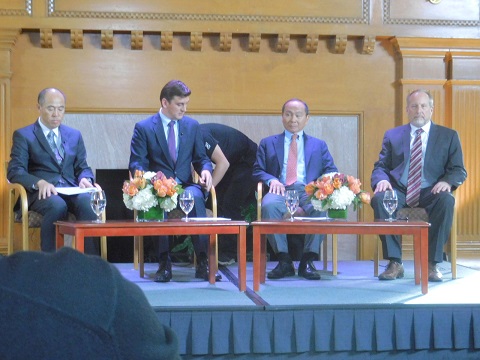
Report:
Led by moderator Takeo Hoshi, the three panelists first presented some key words to describe the essence of Silicon Valley, that is, “Harness” for Kenji Kushida, “Social Capital” for Francis Fukuyama, and “Failure” for William Barnett.
Then they spent some time discussing how these key words could symbolize the success of Silicon Valley as the world’s center of innovation.
In this context, they critically examined Asian economies in general and Japan in particular in terms of business structure and government policy regarding innovation.
Some of the challenges that Silicon Valley is facing toward the future were also discussed.
Although all the four Stanford scholars naturally sounded positive and optimistic about the present and future of Silicon Valley, there seemed to be some difference of opinions among them in assessing the potential of Asian and other economies as “true” innovation centers.
While Kenji Kushida emphasizes the unique role that Silicon Valley so far has been and probably will be playing as the global center of innovation, William Barnett sounded more cautious about the future by referring to some of the innovative enterprises in Asia and Latin America.
The Q&A session was quite useful in clarifying the views of the panelists on innovation, creativity and culture.
(Takahiro Miyao)
----------------------------------------------------------------------
Day 2: February 3, 2016
Seminar “Chronicles of the Silicon Valley-Japan Relationship and Lessons Learned”
Subtitle: An insider’s view of large firms, startup firms, and entrepreneurs since the 1970s
Time: February 3(W), 4:15-6:00pm
Venue: Philippines Conference Room, Encina Hall, Stanford
Speaker:
Masa ISHII, Managing Director of AZCA, Inc, Visiting Professor, Waseda Business School and Shizuoka University
Webpage;
http://www.stanford-synj.org/sv-nj-public-forum-february-3-2016
Photos:
Masa Ishii's presentation and the lively Q&A Session
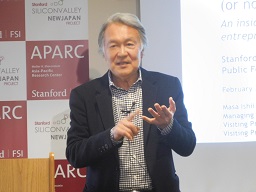
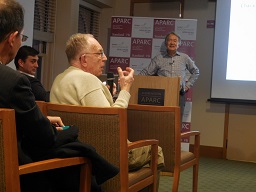
Report:
After going through the recent history of Silicon Valley and its interaction with Japanese companies including his personal history as a bridge between the two difference business cultures, Masa Ishii explained why many of the Japanese large corporations have failed to take full advantage of the ecosystem of Silicon Valley.
He pointed out the "cronic issues facing Japanese companies in Silicon Valley", which include Japan's inward-looking attitude toward innovation, risk aversion, slow decision-making, etc.
His prescription for Japanese companies to benefit from innovative Silicon Valley culture turned out to be quite simple -- adopt top-down management decision-making system, which more and more Japanese companies are subscribing to, due to technological change and global competition.
In the Q&A session, some doubts concerning the real change in Japanese management culture were expressed, but Ishii replied rather optimistically by saying that emerging companies led by relatively young generation of Japanese managers are actually changing in a desirable direction.
However, the seminar ended with a somewhat pessimistic note both on the part of Masa Ishii and most of the audience in terms of Japan's ability to adapt to the IoT era by developing good networking software rather than sticking to its hardware "mono-zukuri" tradition.
(Takahiro Miyao)
--------------------------------------------------------------------------------
---------------------------------------------------------------------
Day 1: February 2, 2016
Symposium “Silicon Valley and Asian Economies”
APARC Japan Program Symposium & NHK World Global Agenda
Time: February 2(T), 3:30-5:00pm
Venue: Bechtel Conference Center, Encina Hall, Stanford
Moderator:
Takeo HOSHI, Director, Japan Program, APARC, Stanford
Panelists:
William BARNETT, Professor, Stanford Graduate School of Business
Francis FUKUYAMA, Director, Center on Democracy, Development, and the Rule of Law, Stanford
Kenji KUSHIDA, Research Associate, Japan Program, APARC
Webpage:
http://aparc.fsi.stanford.edu/events/silicon-valley-and-asian-economies
Photo:
(From left) T. Hoshi, K. Kushida, F. Fukuyama, and W. Barnett

Report:
Led by moderator Takeo Hoshi, the three panelists first presented some key words to describe the essence of Silicon Valley, that is, “Harness” for Kenji Kushida, “Social Capital” for Francis Fukuyama, and “Failure” for William Barnett.
Then they spent some time discussing how these key words could symbolize the success of Silicon Valley as the world’s center of innovation.
In this context, they critically examined Asian economies in general and Japan in particular in terms of business structure and government policy regarding innovation.
Some of the challenges that Silicon Valley is facing toward the future were also discussed.
Although all the four Stanford scholars naturally sounded positive and optimistic about the present and future of Silicon Valley, there seemed to be some difference of opinions among them in assessing the potential of Asian and other economies as “true” innovation centers.
While Kenji Kushida emphasizes the unique role that Silicon Valley so far has been and probably will be playing as the global center of innovation, William Barnett sounded more cautious about the future by referring to some of the innovative enterprises in Asia and Latin America.
The Q&A session was quite useful in clarifying the views of the panelists on innovation, creativity and culture.
(Takahiro Miyao)
----------------------------------------------------------------------
Day 2: February 3, 2016
Seminar “Chronicles of the Silicon Valley-Japan Relationship and Lessons Learned”
Subtitle: An insider’s view of large firms, startup firms, and entrepreneurs since the 1970s
Time: February 3(W), 4:15-6:00pm
Venue: Philippines Conference Room, Encina Hall, Stanford
Speaker:
Masa ISHII, Managing Director of AZCA, Inc, Visiting Professor, Waseda Business School and Shizuoka University
Webpage;
http://www.stanford-synj.org/sv-nj-public-forum-february-3-2016
Photos:
Masa Ishii's presentation and the lively Q&A Session


Report:
After going through the recent history of Silicon Valley and its interaction with Japanese companies including his personal history as a bridge between the two difference business cultures, Masa Ishii explained why many of the Japanese large corporations have failed to take full advantage of the ecosystem of Silicon Valley.
He pointed out the "cronic issues facing Japanese companies in Silicon Valley", which include Japan's inward-looking attitude toward innovation, risk aversion, slow decision-making, etc.
His prescription for Japanese companies to benefit from innovative Silicon Valley culture turned out to be quite simple -- adopt top-down management decision-making system, which more and more Japanese companies are subscribing to, due to technological change and global competition.
In the Q&A session, some doubts concerning the real change in Japanese management culture were expressed, but Ishii replied rather optimistically by saying that emerging companies led by relatively young generation of Japanese managers are actually changing in a desirable direction.
However, the seminar ended with a somewhat pessimistic note both on the part of Masa Ishii and most of the audience in terms of Japan's ability to adapt to the IoT era by developing good networking software rather than sticking to its hardware "mono-zukuri" tradition.
(Takahiro Miyao)
--------------------------------------------------------------------------------
---------------------------------------------------------------------
「冬の経済教室 in Tokyoー授業に役立つ経済学」 [レポート Report]
「冬の経済教室 in Tokyoー授業に役立つ経済学」
日時:2016年1月23日 14:30~16:30
場所:LMJ東京研修センター(東京都文京区本郷)
主催:経済教育ネットワーク、(株)日本取引所ブループ
テーマ:「経済を主体的に学ばせる方法」
報告:
2016年の「冬の経済教室 in Tokyo」では、前回2014年「秋の経済教室」に引き続き、宮尾尊弘筑波大学名誉教授(経済教育ネットワーク理事)が、日本とアメリカの大学で実際に適用した経済学の教授法を紹介し、それを高校の授業にどう活かすかについて提案を行った。
また今回はそれに加えて、金子幹夫神奈川県立平塚農業高校教諭が、高校教育の現場の視点から、提案された教授方法やアイデアをどのように高校生向きの教材に仕立て上げるかについての具体的な例を示したのが特徴で、高校の先生方中心の参加者たちにとって非常に参考になったようであった。
具体的には、「イシューから始める考え方・教え方」と「ゲームのクラス実験で『公共』を学ぶ」というテーマが取り上げられたが、いずれにしても生徒たちに実際の経済問題に対する興味を持たせて、主体的に学習する態度を身につけさせることが経済社会教育の第一歩であり、またそのような方向に進めることが教育的にも社会的にも強く求められることが、熱心に耳を傾ける参加者たちの態度から強く感じられた「経済教室」であった。(宮尾)
講師:(左)宮尾尊弘・筑波大学名誉教授 (右)金子幹夫・神奈川県立平塚農業高校初声分校教諭
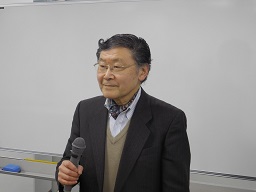
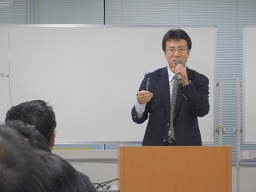
第1部(宮尾):「学習のあり方:イシュー(論点)から始める主体的な学び」
宮尾講演ビデオ(講演の最初6分12秒):https://youtu.be/l-ohyUz4tOU
配布資料の内容要旨:
「イシュー」とは意見の対立がある論点のことで、プロブレム(問題)と同じではない。
生徒に人気があり学ぶ意欲をかきたてる有効な教え方、ただし工夫と準備が必要。
1-1: 「イシュー」から始める教え方(「問題解決型」と同じではない)
1-2: 現実のイシューの例:「TPPの賛否」「パリ協定の有効性」「『貯蓄から投資へ』の是非」
1-3: 目的と効果:ソフトスキル獲得の重要性
1-4: 努力と進歩の評価(適切なフィードバック):「レベル」と「改善率」の両方を評価
第2部(宮尾):「公共経済学を教える方法:ゲームによる競争と協力」
参考:「シンプル経済教室」:https://sites.google.com/site/econeduvideo/
配布資料の内容要旨:
2-1: 「じゃんけんゲーム」(1回限りのゲーム)
2-2: 「じゃんけんゲーム)(繰り返しゲーム)
2-3: 「公共財ただ乗りゲーム」(1回限り、繰り返しゲーム)
第3部(金子):「高校授業現場から:実践にあたって」
金子講演ビデオ(講演の最初5分49秒):https://youtu.be/cZDXhFrVLyQ
配布資料の内容要旨:
3-1: 第1部と第2部の内容を踏まえて、どのように高校で授業を展開したらよいのかを考える。
3-2: キーワード:「その気にさせる」「問いの基盤をつくる」「全員参加」「教科書に戻す」
3-3: 現状分析:自分のフィールド内にいる100名の高校生の授業中の分析
3-4: 具体的な手立て:(1)じゃんけんゲーム、(2)全員参加で考える、(3)イシューから問いに、(4)教科書に戻す、(5)ふりかえる
3-5: おわりに
第4部:参加者全員による意見交流
意見交換風景

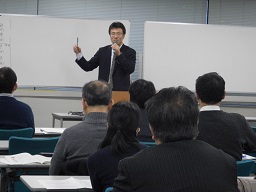
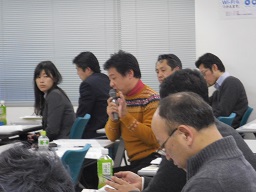
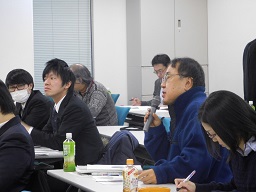
-----------------------------------------------------------------------------------
第1部・第2部 アンケート結果(31名回答、途中参加1名 2-3のみ回答)
第1部:「現実のイシュー(論点)」によって生きた経済を学ぶ意欲を育てる
1-1. 「イシューから始める考え方」の説明は、分かりやすかったですか?
とても分かりやすかった(22人)、多少は分かった(9人) 、どちらとも言えない(2人)、あまりよく分からなかった(0人)、まったく分からなかった(0人)
そのような教え方についての意見・感想:
・「賛成で、実社会との教科のつながりを実感できる」
・「内容が初歩的で授業に役立てるには難しいかもしれない」
1-2.「現実のイシューの例」の説明は、分かりやすかったですか?
とても分かりやすかった(23人)、多少は分かった(6人) 、どちらとも言えない(2人)、あまりよく分からなかった(0人)、まったく分からなかった(0人)
取り上げられたイシューの例についての意見・感想:
・「もっと多くのイシューを挙げてほしい」
・「TPPや地球温暖化等について、多くの高校生は『自分とは関係ない」「どちらでもいい」といって考えようとしないのではないか」
1-3.「目的と効果(ソフトスキル獲得の重要性)」の説明は、分かりやすかったですか?
とても分かりやすかった(13人)、多少は分かった(10人) 、どちらとも言えない(6人)、あまりよく分からなかった(2人)、まったく分からなかった(0人)
説明された目的と効果についての意見・感想:
・「非認知能力の向上の評価が明確化されれば生徒のモチベーションも向上すると思うが、そのような評価方法があればよいと思った」
1-4.「努力と進歩の評価」についての説明は、分かりやすかったですか?
とても分かりやすかった(14人)、多少は分かった(12人) 、どちらとも言えない(3人)、あまりよく分からなかった(2人)、まったく分からなかった(0人)
「努力と進歩の評価」についての意見・感想:
・「大変興味深い内容だが、何らかの数学的処理でうまく組み合わせることができないのかなと思った」
・「大事だと思うが、難しい」
第2部:「公共経済学を教える方法:ゲームによる競争と協力」
2-1. 「じゃんけんゲーム」の説明は、分かりやすかったですか?
とても分かりやすかった(24人)、多少は分かった(6人) 、どちらとも言えない(0人)、あまりよく分からなかった(1人)、まったく分からなかった(0人)
「じゃんけんゲーム」についての意見・感想:
・「ゲーム理論を高校の授業で教えるのがよいかどうか疑問」
2-2. 「じゃんけんゲームのクラス実験」は、何か助けになりましたか?
とても助けになった(15人)、多少は助けになった(11人) 、どちらとも言えない(2人)、あまり助けにならなかった(2人)、まったく助けにならなかった(0人)、無回答(1人)
「じゃんけんゲームのクラス実験」についての意見・感想:
・「金子先生の授業案をベースに発展させて授業してみます」
・「正直なグループで裏切る人の点が高いということをどう表現するか悩む」
2-3. 「公共財ただ乗りゲーム」の説明は、分かりやすかったですか?
とても分かりやすかった(14人)、多少は分かった(15人) 、どちらとも言えない(1人)、あまりよく分からなかった(2人)、まったく分からなかった(0人)
「公共財ただ乗りゲーム」についての意見・感想:
・「面白いと思う。実践してみます」
・「ゲーム理論をどう教科書と結びつけるか、もっと様々な具体例を知りたい」
・「公共の授業で実践する意味・目的について、金子先生の話を聴いてやっと理解できた」
・「具体的な実施方法がよく分からないので、サイト等で調べるつもり」
・「タダ乗りが得をする場合があるということを知らせた後、公共の精神を養うには?」
・「内容が初歩的で授業に役立てるには難しいかもしれない」
(以上)
----------------------------------------------------------------------------------------
日時:2016年1月23日 14:30~16:30
場所:LMJ東京研修センター(東京都文京区本郷)
主催:経済教育ネットワーク、(株)日本取引所ブループ
テーマ:「経済を主体的に学ばせる方法」
報告:
2016年の「冬の経済教室 in Tokyo」では、前回2014年「秋の経済教室」に引き続き、宮尾尊弘筑波大学名誉教授(経済教育ネットワーク理事)が、日本とアメリカの大学で実際に適用した経済学の教授法を紹介し、それを高校の授業にどう活かすかについて提案を行った。
また今回はそれに加えて、金子幹夫神奈川県立平塚農業高校教諭が、高校教育の現場の視点から、提案された教授方法やアイデアをどのように高校生向きの教材に仕立て上げるかについての具体的な例を示したのが特徴で、高校の先生方中心の参加者たちにとって非常に参考になったようであった。
具体的には、「イシューから始める考え方・教え方」と「ゲームのクラス実験で『公共』を学ぶ」というテーマが取り上げられたが、いずれにしても生徒たちに実際の経済問題に対する興味を持たせて、主体的に学習する態度を身につけさせることが経済社会教育の第一歩であり、またそのような方向に進めることが教育的にも社会的にも強く求められることが、熱心に耳を傾ける参加者たちの態度から強く感じられた「経済教室」であった。(宮尾)
講師:(左)宮尾尊弘・筑波大学名誉教授 (右)金子幹夫・神奈川県立平塚農業高校初声分校教諭


第1部(宮尾):「学習のあり方:イシュー(論点)から始める主体的な学び」
宮尾講演ビデオ(講演の最初6分12秒):https://youtu.be/l-ohyUz4tOU
配布資料の内容要旨:
「イシュー」とは意見の対立がある論点のことで、プロブレム(問題)と同じではない。
生徒に人気があり学ぶ意欲をかきたてる有効な教え方、ただし工夫と準備が必要。
1-1: 「イシュー」から始める教え方(「問題解決型」と同じではない)
1-2: 現実のイシューの例:「TPPの賛否」「パリ協定の有効性」「『貯蓄から投資へ』の是非」
1-3: 目的と効果:ソフトスキル獲得の重要性
1-4: 努力と進歩の評価(適切なフィードバック):「レベル」と「改善率」の両方を評価
第2部(宮尾):「公共経済学を教える方法:ゲームによる競争と協力」
参考:「シンプル経済教室」:https://sites.google.com/site/econeduvideo/
配布資料の内容要旨:
2-1: 「じゃんけんゲーム」(1回限りのゲーム)
2-2: 「じゃんけんゲーム)(繰り返しゲーム)
2-3: 「公共財ただ乗りゲーム」(1回限り、繰り返しゲーム)
第3部(金子):「高校授業現場から:実践にあたって」
金子講演ビデオ(講演の最初5分49秒):https://youtu.be/cZDXhFrVLyQ
配布資料の内容要旨:
3-1: 第1部と第2部の内容を踏まえて、どのように高校で授業を展開したらよいのかを考える。
3-2: キーワード:「その気にさせる」「問いの基盤をつくる」「全員参加」「教科書に戻す」
3-3: 現状分析:自分のフィールド内にいる100名の高校生の授業中の分析
3-4: 具体的な手立て:(1)じゃんけんゲーム、(2)全員参加で考える、(3)イシューから問いに、(4)教科書に戻す、(5)ふりかえる
3-5: おわりに
第4部:参加者全員による意見交流
意見交換風景




-----------------------------------------------------------------------------------
第1部・第2部 アンケート結果(31名回答、途中参加1名 2-3のみ回答)
第1部:「現実のイシュー(論点)」によって生きた経済を学ぶ意欲を育てる
1-1. 「イシューから始める考え方」の説明は、分かりやすかったですか?
とても分かりやすかった(22人)、多少は分かった(9人) 、どちらとも言えない(2人)、あまりよく分からなかった(0人)、まったく分からなかった(0人)
そのような教え方についての意見・感想:
・「賛成で、実社会との教科のつながりを実感できる」
・「内容が初歩的で授業に役立てるには難しいかもしれない」
1-2.「現実のイシューの例」の説明は、分かりやすかったですか?
とても分かりやすかった(23人)、多少は分かった(6人) 、どちらとも言えない(2人)、あまりよく分からなかった(0人)、まったく分からなかった(0人)
取り上げられたイシューの例についての意見・感想:
・「もっと多くのイシューを挙げてほしい」
・「TPPや地球温暖化等について、多くの高校生は『自分とは関係ない」「どちらでもいい」といって考えようとしないのではないか」
1-3.「目的と効果(ソフトスキル獲得の重要性)」の説明は、分かりやすかったですか?
とても分かりやすかった(13人)、多少は分かった(10人) 、どちらとも言えない(6人)、あまりよく分からなかった(2人)、まったく分からなかった(0人)
説明された目的と効果についての意見・感想:
・「非認知能力の向上の評価が明確化されれば生徒のモチベーションも向上すると思うが、そのような評価方法があればよいと思った」
1-4.「努力と進歩の評価」についての説明は、分かりやすかったですか?
とても分かりやすかった(14人)、多少は分かった(12人) 、どちらとも言えない(3人)、あまりよく分からなかった(2人)、まったく分からなかった(0人)
「努力と進歩の評価」についての意見・感想:
・「大変興味深い内容だが、何らかの数学的処理でうまく組み合わせることができないのかなと思った」
・「大事だと思うが、難しい」
第2部:「公共経済学を教える方法:ゲームによる競争と協力」
2-1. 「じゃんけんゲーム」の説明は、分かりやすかったですか?
とても分かりやすかった(24人)、多少は分かった(6人) 、どちらとも言えない(0人)、あまりよく分からなかった(1人)、まったく分からなかった(0人)
「じゃんけんゲーム」についての意見・感想:
・「ゲーム理論を高校の授業で教えるのがよいかどうか疑問」
2-2. 「じゃんけんゲームのクラス実験」は、何か助けになりましたか?
とても助けになった(15人)、多少は助けになった(11人) 、どちらとも言えない(2人)、あまり助けにならなかった(2人)、まったく助けにならなかった(0人)、無回答(1人)
「じゃんけんゲームのクラス実験」についての意見・感想:
・「金子先生の授業案をベースに発展させて授業してみます」
・「正直なグループで裏切る人の点が高いということをどう表現するか悩む」
2-3. 「公共財ただ乗りゲーム」の説明は、分かりやすかったですか?
とても分かりやすかった(14人)、多少は分かった(15人) 、どちらとも言えない(1人)、あまりよく分からなかった(2人)、まったく分からなかった(0人)
「公共財ただ乗りゲーム」についての意見・感想:
・「面白いと思う。実践してみます」
・「ゲーム理論をどう教科書と結びつけるか、もっと様々な具体例を知りたい」
・「公共の授業で実践する意味・目的について、金子先生の話を聴いてやっと理解できた」
・「具体的な実施方法がよく分からないので、サイト等で調べるつもり」
・「タダ乗りが得をする場合があるということを知らせた後、公共の精神を養うには?」
・「内容が初歩的で授業に役立てるには難しいかもしれない」
(以上)
----------------------------------------------------------------------------------------
AJEQ 2015年全国大会(改定): Congrès annuel de l'AJÉQ-2015 (Révision) [Photos]
AJEQ 2015年全国大会(改定): Congrès annuel de l'AJÉQ-2015 (Révision) (10/4)
2015 年 10 月 3 日(土): Samedi 3 octobre 2015
会場:跡見学園女子大学(文京キャンパス)2号館4階2401教室:
Lieu: Université Atomi, Otsuka, Bunkyo-ku, Tokyo; Pavillion 2, Salle 2401
大会プログラム Programme
9:15 受付と総合司会 大石太郎(関西学院大学)
Rèception; Modérateur OISHI Taro (Université Kwansei Gakuin)
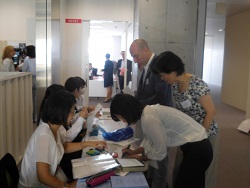
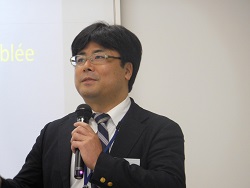
9:45-10 :00 開会 Ouverture
開会の辞 曽田修司(跡見学園女子大学)SOTA Shuji (Université Atomi)
開催校代表挨拶 大塚 博(跡見学園女子大学副学長)OHTSUKA Hiroshi (Vice-recteur de l’Université Atomi)
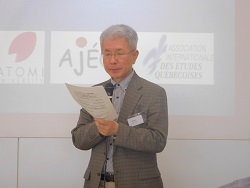
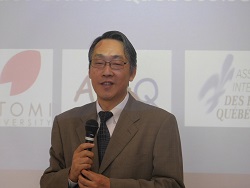
挨拶:クレール・ドゥロンジエ代表(ケベック州政府在日事務所): Claire DERONZIER (Déléguée générale du Québec à Tokyo)、小倉和子会長(立教大学): OGURA Kazuko (Présidente de l’AJEQ, Université Rikkyo)
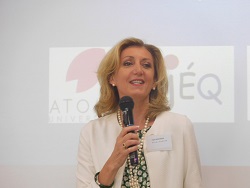
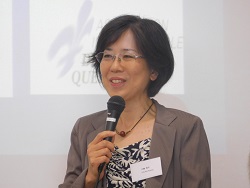
10:00-11:30 自由論題セッション Communications
司会 Modératrice:小松祐子(筑波大学): KOMATSU Sachiko (Université de Tsukuba)
(1)「静かな革命と間文化主義:ケベック史における連続性」
Révolution tranquille et interculturalisme : continuité de l’histoire québécoise
仲村 愛(明治大学大学院)NAKAMURA Ai (Université Meiji, doctorante)
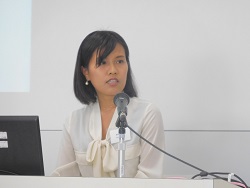
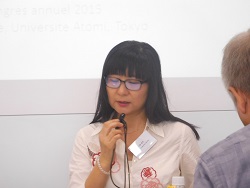
(2)「両大戦間におけるフランス系カナダ・ナショナリズム-リヨネル・グルーを中心に-」Sur le nationalisme des Canadiens français d’entre-deux-guerres-Autour du chanoine Lionel Groulx- 立花英裕(早稲田大学)TACHIBANA Hidehiro (Université Waseda)
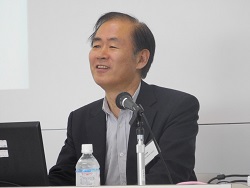
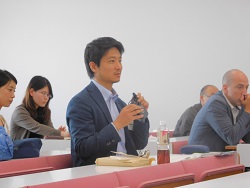
(3) « La quête identitaire et l'identité-relation dans Le premier jardin d’Anne Hébert »(アンヌ・エベールの『初めの庭』におけるアイデンティティの探求とアイデンティティ=関係) LEE Kaya (Université Sungkyunkwan)
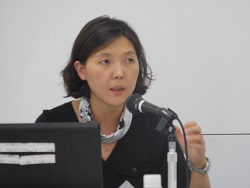
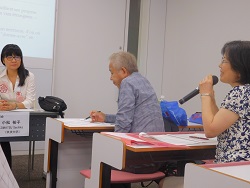
12:00-13:00 総会 Assemblée générale
2015 年度小畑ケベック研究奨励賞授与式
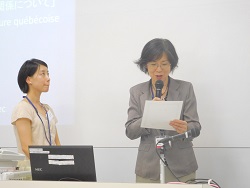
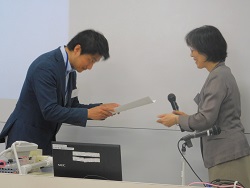
13:00-14:30 ワークショップ Atelier
「州民投票から 20 年-ケベック内政の批判的検討」Qu’en est-il de la situation socio-politique : 20 ans après le Référendum sur la souveraineté au Québec ?
司会・コーディネーター:矢頭典枝(神田外語大学)Modératrice & Coordinatrice : YAZU Norie (Université Kanda des Études internationales)
(1)「1995 年以降のケベック政治の展開」Quebec politics : 20 years after the referendum
田澤卓哉(広島県庁)TAZAWA Takuya (Hiroshima Prefectural Government)
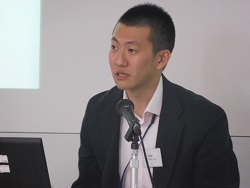
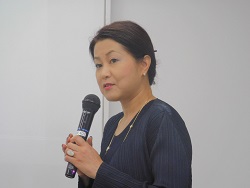
(2)「カナダ・ケベック憲法闘争とケベック・ナショナリズム―州民投票から 20年の今日から振り返る―」Réflexions sur le conflit constitutionnel entre le Québec et le gouvernement fédéral canadien
荒木隆人(岐阜市立女子短期大学)ARAKI Takahito (Institut universitaire pour femmes de la ville de Gifu):コメンテーター:古地順一郎(北海道教育大学函館校)Commentateur : KOJI Junichiro (Université d’Éducation de Hokkaido)
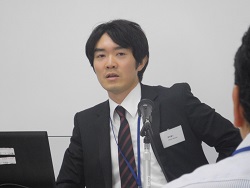
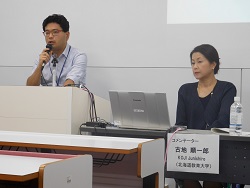
(3)「ケベックの憲法的地位とケベック・レファレンダムの憲法的意味の再考」Revisiting Constitutional Status of Quebec and Constitutional Meaning of Quebec Referenda
佐藤信行(中央大学)SATO Nobuyuki (Université Chuo)
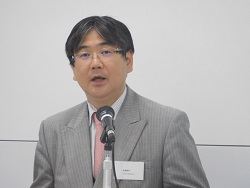
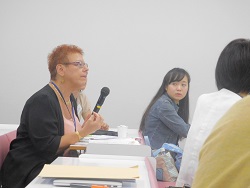
14:45-15:45 基調講演 Conférence
L’intégration scolaire des immigrants et l’éducation interculturelle au Québec : contexte, débats, résultats(ケベックの学校における移民の統合と間文化的教育:その背景・議論・成果)
マリー・マカンドルー教授(モンレアル大学):Marie MC ANDREW (Université de Montréal)
司会・通訳:山出裕子(明治大学)Présentatrice & Interprète :YAMADE Yuko (Université Meiji)
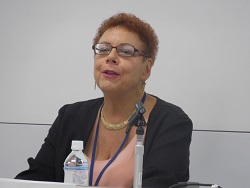
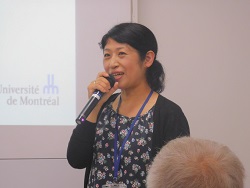
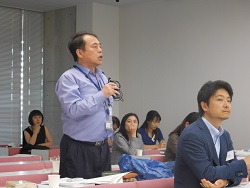
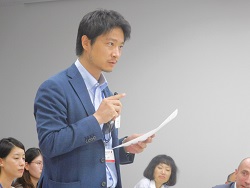
16:00-18:00 シンポジウム Symposium「間文化主義再考」
L’interculturalisme aujourd’hui : quelques réflexions sur sa naissance, son développement et ses polémiques 司会・コーディネーター:小倉和子(立教大学)Modératrice & Coordinatrice : OGURA Kazuko (Université Rikkyo)
ディスカッサント:真田桂子(阪南大学)、伊達聖伸(上智大学)Intervenants : SANADA Keiko (Université Hannnan), DATE Kiyonobu (Université Sophia)
(1)「ケベック文学における間文化主義の誕生」Naissance de l'interculturalisme dans la littérature québécoise 廣松勲(法政大学)HIROMATSU Isao (Université Hosei)
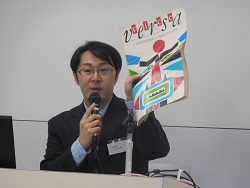
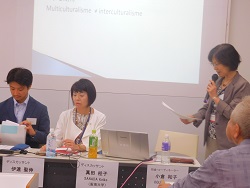
(2)「間文化主義とパフォーミングアーツ」Interculturalisme et art du spectacle
曽田修司(跡見学園女子大学)SOTA Shuji (Université Atomi)
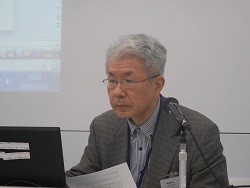
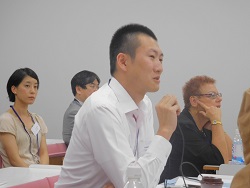
(3)「間文化主義の政策と教育の改革」Politiques interculturelles et réformes du système d'éducation
スティーヴ・コルベイユ(静岡大学)Steve CORBEIL (Université de Shizuoka)
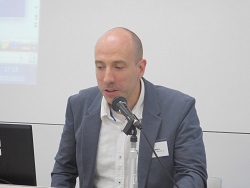
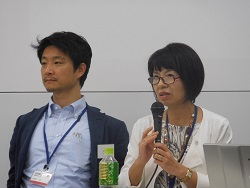
(4)「日常におけるインターカルチュラリズムの実践」L'interculturalisme dans la vie quotidienne
飯笹佐代子(東北文化学園大学)IIZASA Sayoko (Université Tohoku Bunka Gakuen)
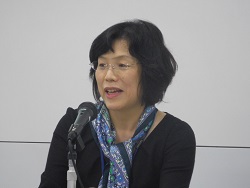
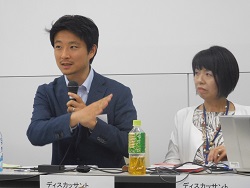
18:00- 閉会 Clôture 副会長挨拶 立花英裕(早稲田大学)TACHIBANA Hidehiro (Vice-président de l’AJEQ, Université Waseda)
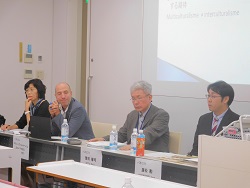
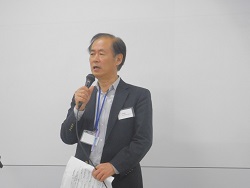

--------------------------------------------------------------------------------------
特別企画・安田敬写真展「ケベックの人々」会場:受付付近
Exposition de YASUDA Kei (Danse café) Visages du Québec, Près de l'Accueil
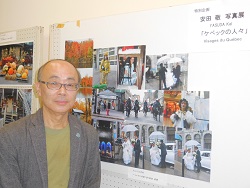


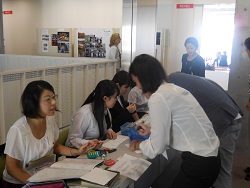
--------------------------------------------------------------------------------------
以上、写真撮影:宮尾(Photos: Miyao)
2015 年 10 月 3 日(土): Samedi 3 octobre 2015
会場:跡見学園女子大学(文京キャンパス)2号館4階2401教室:
Lieu: Université Atomi, Otsuka, Bunkyo-ku, Tokyo; Pavillion 2, Salle 2401
大会プログラム Programme
9:15 受付と総合司会 大石太郎(関西学院大学)
Rèception; Modérateur OISHI Taro (Université Kwansei Gakuin)


9:45-10 :00 開会 Ouverture
開会の辞 曽田修司(跡見学園女子大学)SOTA Shuji (Université Atomi)
開催校代表挨拶 大塚 博(跡見学園女子大学副学長)OHTSUKA Hiroshi (Vice-recteur de l’Université Atomi)


挨拶:クレール・ドゥロンジエ代表(ケベック州政府在日事務所): Claire DERONZIER (Déléguée générale du Québec à Tokyo)、小倉和子会長(立教大学): OGURA Kazuko (Présidente de l’AJEQ, Université Rikkyo)


10:00-11:30 自由論題セッション Communications
司会 Modératrice:小松祐子(筑波大学): KOMATSU Sachiko (Université de Tsukuba)
(1)「静かな革命と間文化主義:ケベック史における連続性」
Révolution tranquille et interculturalisme : continuité de l’histoire québécoise
仲村 愛(明治大学大学院)NAKAMURA Ai (Université Meiji, doctorante)


(2)「両大戦間におけるフランス系カナダ・ナショナリズム-リヨネル・グルーを中心に-」Sur le nationalisme des Canadiens français d’entre-deux-guerres-Autour du chanoine Lionel Groulx- 立花英裕(早稲田大学)TACHIBANA Hidehiro (Université Waseda)


(3) « La quête identitaire et l'identité-relation dans Le premier jardin d’Anne Hébert »(アンヌ・エベールの『初めの庭』におけるアイデンティティの探求とアイデンティティ=関係) LEE Kaya (Université Sungkyunkwan)


12:00-13:00 総会 Assemblée générale
2015 年度小畑ケベック研究奨励賞授与式


13:00-14:30 ワークショップ Atelier
「州民投票から 20 年-ケベック内政の批判的検討」Qu’en est-il de la situation socio-politique : 20 ans après le Référendum sur la souveraineté au Québec ?
司会・コーディネーター:矢頭典枝(神田外語大学)Modératrice & Coordinatrice : YAZU Norie (Université Kanda des Études internationales)
(1)「1995 年以降のケベック政治の展開」Quebec politics : 20 years after the referendum
田澤卓哉(広島県庁)TAZAWA Takuya (Hiroshima Prefectural Government)


(2)「カナダ・ケベック憲法闘争とケベック・ナショナリズム―州民投票から 20年の今日から振り返る―」Réflexions sur le conflit constitutionnel entre le Québec et le gouvernement fédéral canadien
荒木隆人(岐阜市立女子短期大学)ARAKI Takahito (Institut universitaire pour femmes de la ville de Gifu):コメンテーター:古地順一郎(北海道教育大学函館校)Commentateur : KOJI Junichiro (Université d’Éducation de Hokkaido)


(3)「ケベックの憲法的地位とケベック・レファレンダムの憲法的意味の再考」Revisiting Constitutional Status of Quebec and Constitutional Meaning of Quebec Referenda
佐藤信行(中央大学)SATO Nobuyuki (Université Chuo)


14:45-15:45 基調講演 Conférence
L’intégration scolaire des immigrants et l’éducation interculturelle au Québec : contexte, débats, résultats(ケベックの学校における移民の統合と間文化的教育:その背景・議論・成果)
マリー・マカンドルー教授(モンレアル大学):Marie MC ANDREW (Université de Montréal)
司会・通訳:山出裕子(明治大学)Présentatrice & Interprète :YAMADE Yuko (Université Meiji)




16:00-18:00 シンポジウム Symposium「間文化主義再考」
L’interculturalisme aujourd’hui : quelques réflexions sur sa naissance, son développement et ses polémiques 司会・コーディネーター:小倉和子(立教大学)Modératrice & Coordinatrice : OGURA Kazuko (Université Rikkyo)
ディスカッサント:真田桂子(阪南大学)、伊達聖伸(上智大学)Intervenants : SANADA Keiko (Université Hannnan), DATE Kiyonobu (Université Sophia)
(1)「ケベック文学における間文化主義の誕生」Naissance de l'interculturalisme dans la littérature québécoise 廣松勲(法政大学)HIROMATSU Isao (Université Hosei)


(2)「間文化主義とパフォーミングアーツ」Interculturalisme et art du spectacle
曽田修司(跡見学園女子大学)SOTA Shuji (Université Atomi)


(3)「間文化主義の政策と教育の改革」Politiques interculturelles et réformes du système d'éducation
スティーヴ・コルベイユ(静岡大学)Steve CORBEIL (Université de Shizuoka)


(4)「日常におけるインターカルチュラリズムの実践」L'interculturalisme dans la vie quotidienne
飯笹佐代子(東北文化学園大学)IIZASA Sayoko (Université Tohoku Bunka Gakuen)


18:00- 閉会 Clôture 副会長挨拶 立花英裕(早稲田大学)TACHIBANA Hidehiro (Vice-président de l’AJEQ, Université Waseda)



--------------------------------------------------------------------------------------
特別企画・安田敬写真展「ケベックの人々」会場:受付付近
Exposition de YASUDA Kei (Danse café) Visages du Québec, Près de l'Accueil




--------------------------------------------------------------------------------------
以上、写真撮影:宮尾(Photos: Miyao)
シャロン博士夫妻、息子さんとの会話 Talk with Dr & Mrs Charron & their son [レポート Report]
シャロン博士夫妻と道雄さんとの会話:モンレアル(モントリオール)にて(2015年8月29日)
Conversation with Dr. Charron, Misa and Michio Hirai in Montreal
クロード=イヴ・シャロン博士、平井みさ夫人、道雄さん:モンレアルのお宅の裏庭にて
Claude=Yves Charron, Misa and Michio Hirai in the backyard of their house
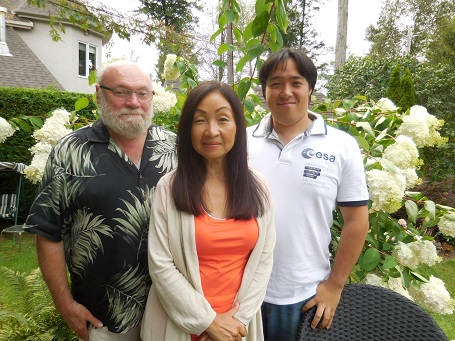
8月29日(土)に、モンレアル郊外にあるクロード=イヴ・シャロン先生のご自宅に招待され、裏庭でランチをごちそうになりながら、先生と奥様のみさ夫人と息子さんの道雄さんとの会話を楽しみました。
まず、シャロン先生はケベックで日本の情報がなかなか入手できず、マスコミも日本の政治・社会・文化などをあまり伝えていないので、情報ギャップを感じている。時折TTP(環太平洋戦略的経済連携協定)の交渉との関連で日本が取り上げられることもあるが、この協定が持つ日本対中国のアジア太平洋地域の覇権に関する地政学的な意味を分析しているものは見当たらないとのこと。
ただし、日本からの情報発信の不十分さもあってマスコミであまり日本が取り上げられないにもかかわらず、こちらの人々は老若男女を問わず、ますます日本の文化や社会に対する関心を高めており、日本についての展示やイベントに多くの人が参加しているとのことで、例えばケベック州最大のアニメ・コンベンションであるOtakuthonや広島原爆投下70周年を記念するケント・ナガノ率いるモンレアル管弦楽団のコンサートなどに大勢の人が参加したそうです。(http://www.rcinet.ca/fr/2015/08/05/hiroshima-70-ans-apres-montreal-sen-souvient/)
これを受けて、みさ夫人がご自分で教えているケベック大学モンレアル校での日本語のコースを履修する学生数は、三年前から急激に増え、今年は350名になり、中国語を履修する学生数の三倍近くにもなったことを指摘されました。これはおそらく学生たちの間で、マンガ、アニメ、ゲーム、映画、ファッション、デザインなどのポップカルチャーへの興味が高まっているためと思われますが、より広い日本文化、歴史、社会などに対する興味に結びつく第一歩であろうと言われていました。
ここで遅れてランチに参加された息子さんの道雄さんが会話に加わり、友達の多くがOtakuthonなどのイベントに参加しており、そのうち何人かが日本に行って大変気に入り、日本に住みたがったが、しかし日本は旅行するのと住むとでは大違いで、東京のような国際都市でもまだ外国人に対する居住および職業上の規制や差別がたくさんあるとコメントされました。一つの例として、過去数年間日本でアニメソングの歌手として活躍したカナダ人の女性歌手のHIMEKAが、昨年所属プロが見つからず日本を去らざるをえなかったことがあげられました。
道雄さん自身も、二年ほど前にインターンで東京に滞在した際、色々と楽しい思いをしたものの、仕事の上で夜10~11時まで仲間と一緒に働かざるをえないという日本人の仕事のやり方にはなかなか慣れなかったとのことでした。
私を含めて四人が会話の結論として、日本には興味深く価値のあるコンテンツやイベントや遺産などがたくさんあることは高く評価できるものの、それらをカナダやその他の国の人々にもっとはっきり分かるようにまた受け入れられやすいように改善し改革する余地もまた多くあるということで同意しました。
参考:
シャロン博士夫妻との会食と意見交換(2008/6/28)
http://japanquebec.blog76.fc2.com/blog-entry-44.html
シャロン博士のインタビュー(2007/8/30)
http://japanquebec.blog76.fc2.com/blog-entry-24.html
------------------------------------------------------------------------------------------
[ English ]
On Saturday, August 29, I was invited to Dr. Claude=Yves Charron’s house in a suburb of Montreal, where I had a very enjoyable conversation with Dr. Charron, his wife Misa Hira along with their son Michio over lunch in their backyard.
First, Dr. Charron pointed out some delays and gaps in information about Japan in Quebec with virtually no reference to Japan’s politics, business, or society in the mass media these days. Even though Japan has sometimes been mentioned in connection with the Trans-Pacific Partnership agreement, no analysis is done regarding its geopolitical implications on Japan vis-à-vis China’s hegemony in the Asia-Pacific region.
However, he said that despite this lack of information about Japan in the mass media, which may at least partly be due to the insufficient information disseminated from Japan, more and more people, both young and old, seem to be attracted to Japanese culture and society and attending various events and exhibitions about Japan, such as Otakuthon, which is Quebec’s largest anime convention, and the Hiroshima memorial concert by the Montreal Symphony Orchestra and its music director, Kent Nagano (http://www.rcinet.ca/fr/2015/08/05/hiroshima-70-ans-apres-montreal-sen-souvient/).
Then, Mrs. Misa Hirai, who is teaching Japanese at the University of Quebec at Montreal, commented that the enrollment in her Japanese language course started to increase significant three years ago and is about 350 students this year, almost three times as many as those studying the Chinese language.
According to her, this may well be due to students’ increasing interest in Japan’s pop culture such as manga, anime, games, movies, fashion, design, etc., and this seems to be a good first step toward wider interests in Japanese culture, history and society in general.
Later their son Michio joined the conversation, saying that quite a few friends of his, who actively participated in Otakuthon and other similar events, have visited Japan and wanted to stay there, but visiting Japan is one thing and living there is another. There are still numerous obstacles for foreigners to live even in a cosmopolitan city like Tokyo, such as formal restrictions and informal discriminations on residential arrangements and professional activities. He pointed out the example of Canadian anime song singer, HIMEKA, who had to give up her career in Japan last year for failing to find a new agency to sponsor her stay after a several years of successful singing career in Japan.
Michio himself, while having mostly enjoyed his stay in Tokyo on his internship program a couple of years ago, sometimes found it difficult to adapt to Japanese behavior at work such as long working hours, staying up with his colleagues until 10 or 11pm.
As a conclusion, the four of us, including myself, agreed that while we all recognize and appreciate so many interesting and valuable contents, events and heritages in Japan, there is much room for improvement and reform to make them more visible and acceptable to the general public in Canada and elsewhere around the world.
References:
Talk with Dr. and Mrs. Charron (6/28/2008):
http://japanquebec.blog76.fc2.com/blog-entry-44.html
Interview with Dr. Charron (8/30/2007):
http://japanquebec.blog76.fc2.com/blog-entry-24.html
---------------------------------------------------------------------------------------
Conversation with Dr. Charron, Misa and Michio Hirai in Montreal
クロード=イヴ・シャロン博士、平井みさ夫人、道雄さん:モンレアルのお宅の裏庭にて
Claude=Yves Charron, Misa and Michio Hirai in the backyard of their house

8月29日(土)に、モンレアル郊外にあるクロード=イヴ・シャロン先生のご自宅に招待され、裏庭でランチをごちそうになりながら、先生と奥様のみさ夫人と息子さんの道雄さんとの会話を楽しみました。
まず、シャロン先生はケベックで日本の情報がなかなか入手できず、マスコミも日本の政治・社会・文化などをあまり伝えていないので、情報ギャップを感じている。時折TTP(環太平洋戦略的経済連携協定)の交渉との関連で日本が取り上げられることもあるが、この協定が持つ日本対中国のアジア太平洋地域の覇権に関する地政学的な意味を分析しているものは見当たらないとのこと。
ただし、日本からの情報発信の不十分さもあってマスコミであまり日本が取り上げられないにもかかわらず、こちらの人々は老若男女を問わず、ますます日本の文化や社会に対する関心を高めており、日本についての展示やイベントに多くの人が参加しているとのことで、例えばケベック州最大のアニメ・コンベンションであるOtakuthonや広島原爆投下70周年を記念するケント・ナガノ率いるモンレアル管弦楽団のコンサートなどに大勢の人が参加したそうです。(http://www.rcinet.ca/fr/2015/08/05/hiroshima-70-ans-apres-montreal-sen-souvient/)
これを受けて、みさ夫人がご自分で教えているケベック大学モンレアル校での日本語のコースを履修する学生数は、三年前から急激に増え、今年は350名になり、中国語を履修する学生数の三倍近くにもなったことを指摘されました。これはおそらく学生たちの間で、マンガ、アニメ、ゲーム、映画、ファッション、デザインなどのポップカルチャーへの興味が高まっているためと思われますが、より広い日本文化、歴史、社会などに対する興味に結びつく第一歩であろうと言われていました。
ここで遅れてランチに参加された息子さんの道雄さんが会話に加わり、友達の多くがOtakuthonなどのイベントに参加しており、そのうち何人かが日本に行って大変気に入り、日本に住みたがったが、しかし日本は旅行するのと住むとでは大違いで、東京のような国際都市でもまだ外国人に対する居住および職業上の規制や差別がたくさんあるとコメントされました。一つの例として、過去数年間日本でアニメソングの歌手として活躍したカナダ人の女性歌手のHIMEKAが、昨年所属プロが見つからず日本を去らざるをえなかったことがあげられました。
道雄さん自身も、二年ほど前にインターンで東京に滞在した際、色々と楽しい思いをしたものの、仕事の上で夜10~11時まで仲間と一緒に働かざるをえないという日本人の仕事のやり方にはなかなか慣れなかったとのことでした。
私を含めて四人が会話の結論として、日本には興味深く価値のあるコンテンツやイベントや遺産などがたくさんあることは高く評価できるものの、それらをカナダやその他の国の人々にもっとはっきり分かるようにまた受け入れられやすいように改善し改革する余地もまた多くあるということで同意しました。
参考:
シャロン博士夫妻との会食と意見交換(2008/6/28)
http://japanquebec.blog76.fc2.com/blog-entry-44.html
シャロン博士のインタビュー(2007/8/30)
http://japanquebec.blog76.fc2.com/blog-entry-24.html
------------------------------------------------------------------------------------------
[ English ]
On Saturday, August 29, I was invited to Dr. Claude=Yves Charron’s house in a suburb of Montreal, where I had a very enjoyable conversation with Dr. Charron, his wife Misa Hira along with their son Michio over lunch in their backyard.
First, Dr. Charron pointed out some delays and gaps in information about Japan in Quebec with virtually no reference to Japan’s politics, business, or society in the mass media these days. Even though Japan has sometimes been mentioned in connection with the Trans-Pacific Partnership agreement, no analysis is done regarding its geopolitical implications on Japan vis-à-vis China’s hegemony in the Asia-Pacific region.
However, he said that despite this lack of information about Japan in the mass media, which may at least partly be due to the insufficient information disseminated from Japan, more and more people, both young and old, seem to be attracted to Japanese culture and society and attending various events and exhibitions about Japan, such as Otakuthon, which is Quebec’s largest anime convention, and the Hiroshima memorial concert by the Montreal Symphony Orchestra and its music director, Kent Nagano (http://www.rcinet.ca/fr/2015/08/05/hiroshima-70-ans-apres-montreal-sen-souvient/).
Then, Mrs. Misa Hirai, who is teaching Japanese at the University of Quebec at Montreal, commented that the enrollment in her Japanese language course started to increase significant three years ago and is about 350 students this year, almost three times as many as those studying the Chinese language.
According to her, this may well be due to students’ increasing interest in Japan’s pop culture such as manga, anime, games, movies, fashion, design, etc., and this seems to be a good first step toward wider interests in Japanese culture, history and society in general.
Later their son Michio joined the conversation, saying that quite a few friends of his, who actively participated in Otakuthon and other similar events, have visited Japan and wanted to stay there, but visiting Japan is one thing and living there is another. There are still numerous obstacles for foreigners to live even in a cosmopolitan city like Tokyo, such as formal restrictions and informal discriminations on residential arrangements and professional activities. He pointed out the example of Canadian anime song singer, HIMEKA, who had to give up her career in Japan last year for failing to find a new agency to sponsor her stay after a several years of successful singing career in Japan.
Michio himself, while having mostly enjoyed his stay in Tokyo on his internship program a couple of years ago, sometimes found it difficult to adapt to Japanese behavior at work such as long working hours, staying up with his colleagues until 10 or 11pm.
As a conclusion, the four of us, including myself, agreed that while we all recognize and appreciate so many interesting and valuable contents, events and heritages in Japan, there is much room for improvement and reform to make them more visible and acceptable to the general public in Canada and elsewhere around the world.
References:
Talk with Dr. and Mrs. Charron (6/28/2008):
http://japanquebec.blog76.fc2.com/blog-entry-44.html
Interview with Dr. Charron (8/30/2007):
http://japanquebec.blog76.fc2.com/blog-entry-24.html
---------------------------------------------------------------------------------------
ケベック州政府国際関係省での対話 Conversation at Quebec Gov’t Ministry of Int’l Relations (MRIF) [Report]
ケベック州政府国際関係省での対話(2015年8月31日)
Conversation at Quebec Gov’t Ministry of Int’l Relations (MRIF)
エティエンヌ・バイヤルジョン氏、モード・コテ女史、ドナルド・ルブラン氏
M. Etienne Baillargeon, Mme. Maude Cote, and M. Donald Leblanc
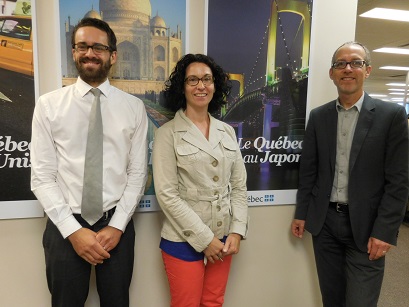
8月31日(月)に、ケベック市の州政府国際関係省(MRIF)の本部を訪れ、アジア・日本担当であるドナルド・ルブラン氏(アジア太平洋、ラテンアメリカ、カリブ諸国担当ディレクター)、モード・コテ女史(日本、韓国、オセアニア担当チーフ)とエティエンヌ・バイヤルジョン氏(日本、韓国、オセアニア担当官)の3名と会うことができた。
州政府の担当者と会見する目的は、日本とケベックにかかわる最近の文化活動についての意見や情報を交換することであった。
最初に驚いたのは、ケベックの担当官たちが日本のポップカルチャーやクールジャパンに対して持つ関心の強さで、その質問に答えて、まず私から日本政府がアニメ、マンガ、ゲーム、映画、ファッション、デザイン、さらには和食などのポピュラーカルチャーを支援してそれに関するグッズやサービスを海外に売り込むとともに、2016年の三重県伊勢志摩サミットや2020の東京オリンピックに向けて外国人の観光客を日本に呼び込もうという最近のクールジャパン戦略について説明した。
実際、ここでこのようなテーマについて議論するのはタイミング的にも場所的にもまさにベストで、ちょうど州政府の庁舎の近くにあるケベック州美術館(http://www.mnbaq.org/)で、日本に関する特別展示が行われていた。それは「ジャポニズム」の時代を取り上げた「Inspiration Japon」とケベックのアーティストによる日本の伝統を題材とするポップアート「Nippon-Fiction」というもので、私は国際関係省を訪れる前にこれらの展示を見て回って大いにエンジョイすることができた。
それから州政府担当者たちと、日本とケベックの間でどのようにアーティストやクリエーターの交流を促進することができるかを議論したが、すでにダンスパフォーマーについてはケベックから何人かが州政府の支援を得て日本に短期間滞在し交流を深めているが、逆に日本のアーティストやパフォーマーが日本政府の支援でケベックに滞在するプログラムはこれまでなかったのではないかという点が、州政府担当者から指摘された。それについては、アニメ、マンガ、ゲーム、映画、日本食料理などの分野で、現在日本政府が「クールジャパン戦略」の一環として考えているのではないかという期待も表明された。
さらに、日本とケベックのアーティストやクリエーターとスポンサーやビジネスの間を取り持って、情報交換やビジネス交流を促進するようなプラットフォームのウェブサイトを立ち上げる可能性などが議論されたが、重要な問題は、どうやって質的および法律的な要件をクリアーして、国境を越えた真の協力を促進することができるかということであった。暫定的な結論は、まず第一歩として、例えば日本とケベックの映画産業の協会などが相互の交流を促進するためのプラットフォームづくりに興味を示すべきで、そのような段階を踏んで、やがて長期的により包括的で横断的な形でアーティストやクリエーターと受け入れ機関やビジネス組織とを引き合わせるプラットフォームが生まれてくるであろうという展望が示された。
指摘されるべきは、以上のような議論がすべて予定通り1時間以内に行われたということで、それはケベック政府ないし国際関係省がいかに物事を効率的に処理しているかを示しているものと思われる。その間、3名の担当官は非常に友好的かつ生産的な態度で接してくれたことが印象的であった。そのような態度から日本の政府関係者も大いに学んでほしいものである。
参考:
日本でのケベック州首相の講演(2011年8月)
http://japanquebec.blog76.fc2.com/blog-entry-76.html
モンレアル・ケベック訪問(2007年8月)
http://japanquebec.blog76.fc2.com/blog-date-200709.html
------------------------------------------------------------------------------------------
Conversation at Quebec Gov’t Ministry of Int’l Relations (MRIF)
On Monday, August 31, I visited the Ministry of International Relations and Francophonie (MRIF) at the Headquarter Building in Quebec city, where I was greeted by three officials in charge of Asia and Japan, M. Donald Leblanc (Asia-Pacific, Latin America and Caribbean Director), Mme. Maude Cote (Chief of the Japan, Korea and Oceania Desk), and M. Etienne Baillargeon (Officer at the Japan, Korea and Oceania Desk).
The main purpose of my visit was to exchange opinions and information with the Quebec officials about recent cultural activities concerning both Japan and Quebec.
First, in response to the surprisingly strong interest in Japan’s pop culture and the “Cool Japan” concept on the part of the Quebec officials, I tried to outline the recent strategy of the Japanese government to promote and support Japan’s popular culture such as anime, manga, games, films, fashion, design, cuisine, etc. for the purpose of marketing pop culture-related goods and services abroad as well as attracting foreign tourists to Japan in connection with the 2016 Summit in Mie Prefecture and the 2020 Olympics in Tokyo.
The timing and location for our discussion on this subject matter seemed perfect, as the National Museum of Fine Arts of Quebec near the Parliament Building (http://www.mnbaq.org/) was featuring the special exhibitions about Japan, “Inspiration Japon” (Japonism) and “Nippon-Fiction” (a Quebec artist’s traditional Japanese-style pop culture), which I enjoyed viewing, prior to my meeting at the Ministry.
Then, we discussed possible ways to encourage the exchange of artists and creators between Japan and Quebec. As pointed out by the officials, a number of Quebec artists such as dance performers have visited Japan for a short stay supported by the Quebec government, but there has not been any such arrangement for Japanese artists to stay in Quebec supported by the Japanese government so far, and it might well be under consideration by the Japanese government in the context of the Cool Japan strategy, especially in some pop culture fields such as anime, manga, games, films, cuisine, etc.
Then our discussion led to a possibility of creating a kind of “matching site” as a platform to introduce artists and creators on one hand and sponsors and business people on the other to facilitate mutual exchange of information and possibly business interaction between Japan and Quebec. However, the important question about this idea is how to meet the “quality” and “legal” requirements for real collaboration between them across national boundaries. Our tentative conclusion was that as a first step professional organizations such as film industries in Japan and Quebec could be interested in creating a platform for more active interactions between Japanese and Quebec film industries. As a result of this kind of step-by-step approach, a more comprehensive, across-the-board matching platform for artists/creators and hosting/business organizations might emerge in the long run.
All this discussion took place within an hour as planned, which implies how efficient the Quebec government, or at least the MRIF, operates, and I truly enjoyed talking with those three officials in such a friendly and productive manner, hoping that Japanese government officials could learn from them in this respect.
References:
Quebec Premier’s speech in Japan (August, 2011):
http://japanquebec.blog76.fc2.com/blog-entry-76.html
My visit to Montreal and Quebec city (August, 2007):
http://japanquebec.blog76.fc2.com/blog-date-200709.html
------------------------------------------------------------------------------------------
Conversation at Quebec Gov’t Ministry of Int’l Relations (MRIF)
エティエンヌ・バイヤルジョン氏、モード・コテ女史、ドナルド・ルブラン氏
M. Etienne Baillargeon, Mme. Maude Cote, and M. Donald Leblanc

8月31日(月)に、ケベック市の州政府国際関係省(MRIF)の本部を訪れ、アジア・日本担当であるドナルド・ルブラン氏(アジア太平洋、ラテンアメリカ、カリブ諸国担当ディレクター)、モード・コテ女史(日本、韓国、オセアニア担当チーフ)とエティエンヌ・バイヤルジョン氏(日本、韓国、オセアニア担当官)の3名と会うことができた。
州政府の担当者と会見する目的は、日本とケベックにかかわる最近の文化活動についての意見や情報を交換することであった。
最初に驚いたのは、ケベックの担当官たちが日本のポップカルチャーやクールジャパンに対して持つ関心の強さで、その質問に答えて、まず私から日本政府がアニメ、マンガ、ゲーム、映画、ファッション、デザイン、さらには和食などのポピュラーカルチャーを支援してそれに関するグッズやサービスを海外に売り込むとともに、2016年の三重県伊勢志摩サミットや2020の東京オリンピックに向けて外国人の観光客を日本に呼び込もうという最近のクールジャパン戦略について説明した。
実際、ここでこのようなテーマについて議論するのはタイミング的にも場所的にもまさにベストで、ちょうど州政府の庁舎の近くにあるケベック州美術館(http://www.mnbaq.org/)で、日本に関する特別展示が行われていた。それは「ジャポニズム」の時代を取り上げた「Inspiration Japon」とケベックのアーティストによる日本の伝統を題材とするポップアート「Nippon-Fiction」というもので、私は国際関係省を訪れる前にこれらの展示を見て回って大いにエンジョイすることができた。
それから州政府担当者たちと、日本とケベックの間でどのようにアーティストやクリエーターの交流を促進することができるかを議論したが、すでにダンスパフォーマーについてはケベックから何人かが州政府の支援を得て日本に短期間滞在し交流を深めているが、逆に日本のアーティストやパフォーマーが日本政府の支援でケベックに滞在するプログラムはこれまでなかったのではないかという点が、州政府担当者から指摘された。それについては、アニメ、マンガ、ゲーム、映画、日本食料理などの分野で、現在日本政府が「クールジャパン戦略」の一環として考えているのではないかという期待も表明された。
さらに、日本とケベックのアーティストやクリエーターとスポンサーやビジネスの間を取り持って、情報交換やビジネス交流を促進するようなプラットフォームのウェブサイトを立ち上げる可能性などが議論されたが、重要な問題は、どうやって質的および法律的な要件をクリアーして、国境を越えた真の協力を促進することができるかということであった。暫定的な結論は、まず第一歩として、例えば日本とケベックの映画産業の協会などが相互の交流を促進するためのプラットフォームづくりに興味を示すべきで、そのような段階を踏んで、やがて長期的により包括的で横断的な形でアーティストやクリエーターと受け入れ機関やビジネス組織とを引き合わせるプラットフォームが生まれてくるであろうという展望が示された。
指摘されるべきは、以上のような議論がすべて予定通り1時間以内に行われたということで、それはケベック政府ないし国際関係省がいかに物事を効率的に処理しているかを示しているものと思われる。その間、3名の担当官は非常に友好的かつ生産的な態度で接してくれたことが印象的であった。そのような態度から日本の政府関係者も大いに学んでほしいものである。
参考:
日本でのケベック州首相の講演(2011年8月)
http://japanquebec.blog76.fc2.com/blog-entry-76.html
モンレアル・ケベック訪問(2007年8月)
http://japanquebec.blog76.fc2.com/blog-date-200709.html
------------------------------------------------------------------------------------------
Conversation at Quebec Gov’t Ministry of Int’l Relations (MRIF)
On Monday, August 31, I visited the Ministry of International Relations and Francophonie (MRIF) at the Headquarter Building in Quebec city, where I was greeted by three officials in charge of Asia and Japan, M. Donald Leblanc (Asia-Pacific, Latin America and Caribbean Director), Mme. Maude Cote (Chief of the Japan, Korea and Oceania Desk), and M. Etienne Baillargeon (Officer at the Japan, Korea and Oceania Desk).
The main purpose of my visit was to exchange opinions and information with the Quebec officials about recent cultural activities concerning both Japan and Quebec.
First, in response to the surprisingly strong interest in Japan’s pop culture and the “Cool Japan” concept on the part of the Quebec officials, I tried to outline the recent strategy of the Japanese government to promote and support Japan’s popular culture such as anime, manga, games, films, fashion, design, cuisine, etc. for the purpose of marketing pop culture-related goods and services abroad as well as attracting foreign tourists to Japan in connection with the 2016 Summit in Mie Prefecture and the 2020 Olympics in Tokyo.
The timing and location for our discussion on this subject matter seemed perfect, as the National Museum of Fine Arts of Quebec near the Parliament Building (http://www.mnbaq.org/) was featuring the special exhibitions about Japan, “Inspiration Japon” (Japonism) and “Nippon-Fiction” (a Quebec artist’s traditional Japanese-style pop culture), which I enjoyed viewing, prior to my meeting at the Ministry.
Then, we discussed possible ways to encourage the exchange of artists and creators between Japan and Quebec. As pointed out by the officials, a number of Quebec artists such as dance performers have visited Japan for a short stay supported by the Quebec government, but there has not been any such arrangement for Japanese artists to stay in Quebec supported by the Japanese government so far, and it might well be under consideration by the Japanese government in the context of the Cool Japan strategy, especially in some pop culture fields such as anime, manga, games, films, cuisine, etc.
Then our discussion led to a possibility of creating a kind of “matching site” as a platform to introduce artists and creators on one hand and sponsors and business people on the other to facilitate mutual exchange of information and possibly business interaction between Japan and Quebec. However, the important question about this idea is how to meet the “quality” and “legal” requirements for real collaboration between them across national boundaries. Our tentative conclusion was that as a first step professional organizations such as film industries in Japan and Quebec could be interested in creating a platform for more active interactions between Japanese and Quebec film industries. As a result of this kind of step-by-step approach, a more comprehensive, across-the-board matching platform for artists/creators and hosting/business organizations might emerge in the long run.
All this discussion took place within an hour as planned, which implies how efficient the Quebec government, or at least the MRIF, operates, and I truly enjoyed talking with those three officials in such a friendly and productive manner, hoping that Japanese government officials could learn from them in this respect.
References:
Quebec Premier’s speech in Japan (August, 2011):
http://japanquebec.blog76.fc2.com/blog-entry-76.html
My visit to Montreal and Quebec city (August, 2007):
http://japanquebec.blog76.fc2.com/blog-date-200709.html
------------------------------------------------------------------------------------------
マルセル・マルテル教授との対話 Conversation with Prof. Marcel Martel [レポート Report]
マルセル・マルテル教授との対話 @ヨーク大学(2015年9月2日)
Conversation with Prof. Marcel Martel @York University (Sept. 2, 2015)
マルセル・マルテル教授と最新著書:Prof. Marcel Martel & His Most Recent Book
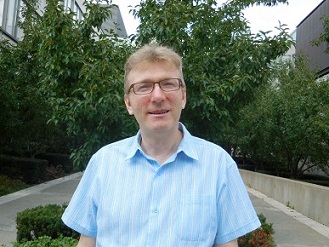
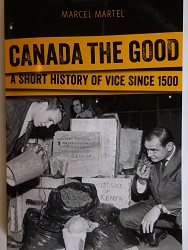
9月2日(火)にトロントのヨーク大学を訪れ、マルセル・マルテル教授に会って、現在進めている研究についてお聞きした。ちょうと秋学期が始まる直前だったため、キャンパスはとても静かで、居心地のよい教員用のダイニングルームでランチを取りながらゆっくり話をすることができた。
まずマルテル教授は、最新の著書『Canada the Good』(2014年)に言及し、昨年日本で行った講演のいくつかはこの著書の内容に基づいていたことを指摘した。さらに現在行っている研究テーマは何かという質問に対しては、「カナダ人のアイデンティティ」というテーマに取り組んでいるとのことであった。実際に、英語を母国語とするカナダ人の多くはヴィクトリア王女の誕生日を祝い、フランス語を母国語とするカナダ人はセントジョン・バプティストの日を祝うといったような社会で、カナダ人のアイデンティティがどう定義され、どう共有されるのかはまだ不明である。
それは、アメリカ合衆国のような「メルティング・ポット(るつぼ)社会」と異なり、カナダのような「モザイク社会」では、いつまでも引きずっていく問題ともいえる。したがって、マルテル教授の野心的な研究の成果が、いかに暫定的なものであっても、今から期待されるところである。
その後、話題は日本のポップカルチャーのトピックに移り、マルテル教授によれば、このところアニメ、マンガ、寿司などがトロントで大いに注目を集めているとのことであった。日本食については、その主な食材である魚や野菜が健康食として認識されたことが人気に火をつけたといえるが、この「ハイカルチャー」という性格は日本のポップカルチャーの他のジャンルにも当てはまり、例えばアニメでは、宮崎駿の芸術的なアニメが日本のアニメを、子供用のコミックというよりは、一種の芸術作品にしたことが、広く世界中の老若男女を引き付ける結果になったといえる。
マルテル教授との話の結論として、ある国のポピュラーカルチャーが他国に浸透する歴史と戦略について比較研究することは、例えば日本と韓国のポップカルチャーが北アメリカで受け入れられる過程の違いを研究するといったように非常に興味深いものではないかということであった。
参考:
マルセル・マルテル著『Canada the Good: A Short History of Vice since 1500』(2014年、 WLU Press)
http://www.wlupress.wlu.ca/Catalog/martel-m.shtml
マルセル・マルテル教授の日本での講演(2014年10~11月)
http://ajeq14.blog.fc2.com/blog-entry-19.html
-------------------------------------------------------------------------------------------
Conversation with Prof. Marcel Martel @York University
On Wednesday, September 2, I visited York University in Toronto, where I met Professor Marcel Martel and asked him about his current research interest. Since it was just before the fall semester starts, the campus was very quiet and we had a leisurely conversation over lunch at a nice faculty dining room.
First, Prof. Martel referred to his new book, Canada the Good: A Short History of Vice since 1500 (2014), which was a basis for some of the speeches that he gave in Japan last year. Then, in response to my question about his current research agenda, he said he is now working on the issue of the “Canadian identity,” which is yet to be defined and shared by all citizens in a society, where most of the English-speaking Canadians celebrate Queen Victoria’s Birthday, French-speaking Canadians honor St Jean-Baptiste Day, etc.
That sounded like an ever-lingering problem in what might be called a “mosaic” society, rather than a “melting pot” like the United States of America. So, I am anxious to know a conclusion, however tentative, of his ambitious research to deal with this problem.
Then, our conversation turned to the topic of Japanese popular culture such as anime, manga and sushi, which are attracting more and more attention from Torontonians these days, according to Prof. Martel. He pointed out that, especially in the case of Japanese food, it has become so popular, because it is healthy to each fish and vegetables, which are the main ingredients of Japanese cuisine. This “high culture” aspect might also apply to other genres of Japanese pop culture such as anime, where Hayao Miyazaki’s artistic works have made Japanese amine a kind of fine art, rather than children’s comics, leading to the wide popularity among the young and the old all over the world.
Prof. Martel and I agreed that it would be quite interesting to study the history and strategy of a country’s popular culture to penetrate into other countries with different cultural backgrounds from the comparative viewpoint, such as Japanese vs. Korean pop culture accepted in North America in somewhat different ways.
References:
Marcel Martel, Canada the Good: A Short History of Vice since 1500 (WLU Press, 2014):
http://www.wlupress.wlu.ca/Catalog/martel-m.shtml
Reports on Prof. Marcel Martel’s lectures in Japan (October/November 2014):
http://ajeq14.blog.fc2.com/blog-entry-19.html
-------------------------------------------------------------------------------------------
Conversation with Prof. Marcel Martel @York University (Sept. 2, 2015)
マルセル・マルテル教授と最新著書:Prof. Marcel Martel & His Most Recent Book


9月2日(火)にトロントのヨーク大学を訪れ、マルセル・マルテル教授に会って、現在進めている研究についてお聞きした。ちょうと秋学期が始まる直前だったため、キャンパスはとても静かで、居心地のよい教員用のダイニングルームでランチを取りながらゆっくり話をすることができた。
まずマルテル教授は、最新の著書『Canada the Good』(2014年)に言及し、昨年日本で行った講演のいくつかはこの著書の内容に基づいていたことを指摘した。さらに現在行っている研究テーマは何かという質問に対しては、「カナダ人のアイデンティティ」というテーマに取り組んでいるとのことであった。実際に、英語を母国語とするカナダ人の多くはヴィクトリア王女の誕生日を祝い、フランス語を母国語とするカナダ人はセントジョン・バプティストの日を祝うといったような社会で、カナダ人のアイデンティティがどう定義され、どう共有されるのかはまだ不明である。
それは、アメリカ合衆国のような「メルティング・ポット(るつぼ)社会」と異なり、カナダのような「モザイク社会」では、いつまでも引きずっていく問題ともいえる。したがって、マルテル教授の野心的な研究の成果が、いかに暫定的なものであっても、今から期待されるところである。
その後、話題は日本のポップカルチャーのトピックに移り、マルテル教授によれば、このところアニメ、マンガ、寿司などがトロントで大いに注目を集めているとのことであった。日本食については、その主な食材である魚や野菜が健康食として認識されたことが人気に火をつけたといえるが、この「ハイカルチャー」という性格は日本のポップカルチャーの他のジャンルにも当てはまり、例えばアニメでは、宮崎駿の芸術的なアニメが日本のアニメを、子供用のコミックというよりは、一種の芸術作品にしたことが、広く世界中の老若男女を引き付ける結果になったといえる。
マルテル教授との話の結論として、ある国のポピュラーカルチャーが他国に浸透する歴史と戦略について比較研究することは、例えば日本と韓国のポップカルチャーが北アメリカで受け入れられる過程の違いを研究するといったように非常に興味深いものではないかということであった。
参考:
マルセル・マルテル著『Canada the Good: A Short History of Vice since 1500』(2014年、 WLU Press)
http://www.wlupress.wlu.ca/Catalog/martel-m.shtml
マルセル・マルテル教授の日本での講演(2014年10~11月)
http://ajeq14.blog.fc2.com/blog-entry-19.html
-------------------------------------------------------------------------------------------
Conversation with Prof. Marcel Martel @York University
On Wednesday, September 2, I visited York University in Toronto, where I met Professor Marcel Martel and asked him about his current research interest. Since it was just before the fall semester starts, the campus was very quiet and we had a leisurely conversation over lunch at a nice faculty dining room.
First, Prof. Martel referred to his new book, Canada the Good: A Short History of Vice since 1500 (2014), which was a basis for some of the speeches that he gave in Japan last year. Then, in response to my question about his current research agenda, he said he is now working on the issue of the “Canadian identity,” which is yet to be defined and shared by all citizens in a society, where most of the English-speaking Canadians celebrate Queen Victoria’s Birthday, French-speaking Canadians honor St Jean-Baptiste Day, etc.
That sounded like an ever-lingering problem in what might be called a “mosaic” society, rather than a “melting pot” like the United States of America. So, I am anxious to know a conclusion, however tentative, of his ambitious research to deal with this problem.
Then, our conversation turned to the topic of Japanese popular culture such as anime, manga and sushi, which are attracting more and more attention from Torontonians these days, according to Prof. Martel. He pointed out that, especially in the case of Japanese food, it has become so popular, because it is healthy to each fish and vegetables, which are the main ingredients of Japanese cuisine. This “high culture” aspect might also apply to other genres of Japanese pop culture such as anime, where Hayao Miyazaki’s artistic works have made Japanese amine a kind of fine art, rather than children’s comics, leading to the wide popularity among the young and the old all over the world.
Prof. Martel and I agreed that it would be quite interesting to study the history and strategy of a country’s popular culture to penetrate into other countries with different cultural backgrounds from the comparative viewpoint, such as Japanese vs. Korean pop culture accepted in North America in somewhat different ways.
References:
Marcel Martel, Canada the Good: A Short History of Vice since 1500 (WLU Press, 2014):
http://www.wlupress.wlu.ca/Catalog/martel-m.shtml
Reports on Prof. Marcel Martel’s lectures in Japan (October/November 2014):
http://ajeq14.blog.fc2.com/blog-entry-19.html
-------------------------------------------------------------------------------------------
Art vs Real Thing on UCLA Campus: 芸術VS実物@UCLAキャンパス [Photos]
Art vs Real Thing on UCLA Campus: 芸術と実物の対比@UCLA
Late May-Early June; 2015年5月末~6月初め
UCLA Campus; UCLAキャンパス
Painting (@Faculty Center); 絵画(@ファカルティ・センター)


Sculpture (@Sculpture Garden); 彫刻(@彫刻の庭)
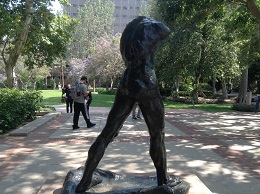
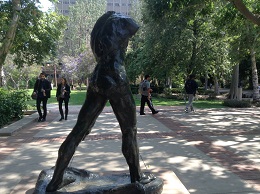
Pop Art (?); ポップアート(?)
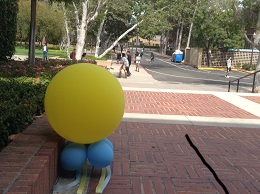
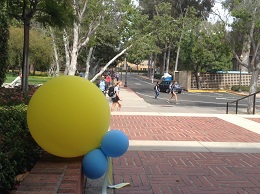
-------------------------------------------------------------------------------------------
Late May-Early June; 2015年5月末~6月初め
UCLA Campus; UCLAキャンパス
Painting (@Faculty Center); 絵画(@ファカルティ・センター)


Sculpture (@Sculpture Garden); 彫刻(@彫刻の庭)


Pop Art (?); ポップアート(?)


-------------------------------------------------------------------------------------------
Colorful Spring on UCLA Campus: カラフルな春のUCLAキャンパス [Photos]
Colorful Spring on UCLA Campus: カラフルな春のUCLAキャンパス
Date: April 14-23; 2015年4月14日~23日
Place: From Sculpture Garden to Faculty Center; 彫刻の庭からファカルティセンターまで
Jacaranda Color on Campus; ジャカランダの色に染まるキャンパス
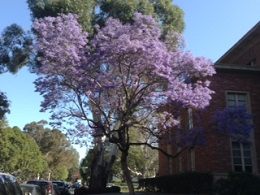

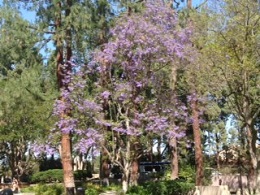
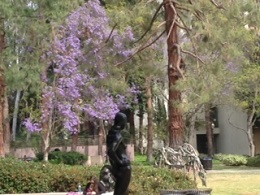
Other Colors on Campus; その他のキャンパスでの色
(A girl's shadow? on the tree trunk; 木の幹に少女の影?)
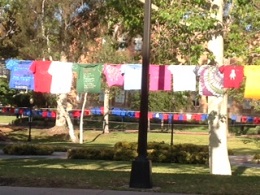
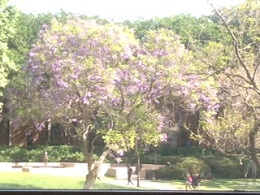
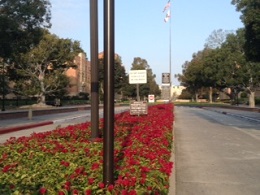

Reference:
Faculty Center Photo Gallery; ファカルティセンター写真集
http://facultycenter.ucla.edu/Photo-Gallery/General-Photo-Gallery.aspx
------------------------------------------------------------------------------------------
Date: April 14-23; 2015年4月14日~23日
Place: From Sculpture Garden to Faculty Center; 彫刻の庭からファカルティセンターまで
Jacaranda Color on Campus; ジャカランダの色に染まるキャンパス




Other Colors on Campus; その他のキャンパスでの色
(A girl's shadow? on the tree trunk; 木の幹に少女の影?)




Reference:
Faculty Center Photo Gallery; ファカルティセンター写真集
http://facultycenter.ucla.edu/Photo-Gallery/General-Photo-Gallery.aspx
------------------------------------------------------------------------------------------
Morning Sunrise on UCLA Campus (April 9): UCLAの日の出(4/9) [写真]
Morning Sunrise on UCLA Campus (April 9): UCLAの日の出(4/9)
Date: Thursday, April 9: 2015年4月9日(木)
Place: Around the Sculpture Garden@UCLA: 彫刻の庭周辺
"Softly as in the Spring Morning Sunrise"
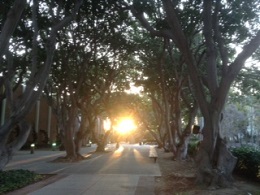
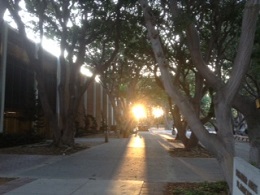
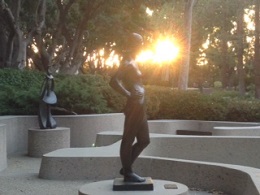
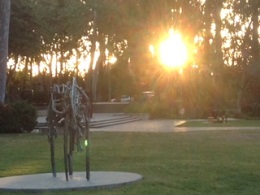
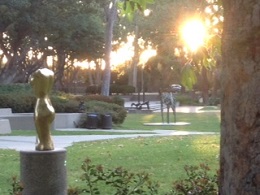
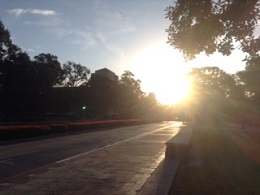
-----------------------------------------------------------------------------------------
Date: Thursday, April 9: 2015年4月9日(木)
Place: Around the Sculpture Garden@UCLA: 彫刻の庭周辺
"Softly as in the Spring Morning Sunrise"






-----------------------------------------------------------------------------------------
More Flowers on UCLA Campus (March 31): UCLAキャンパスの花(3/31) [Photos]
More Flowers on UCLA Campus (March 31): UCLAキャンパスの花(3/31)
Date: Tuesday, March 31: 2015年3月31日(火)
Place: Around Royce Hall@UCLA: ロイスホール周辺
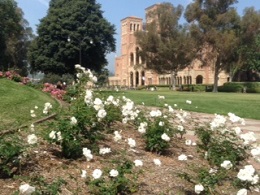
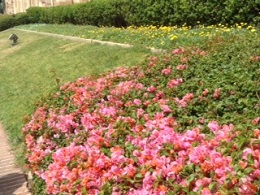
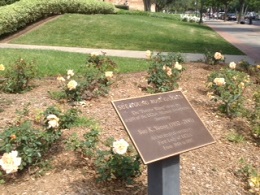
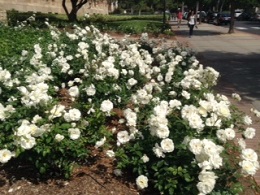
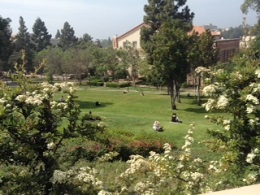
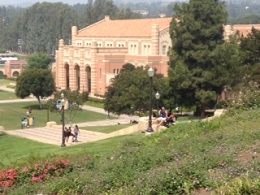
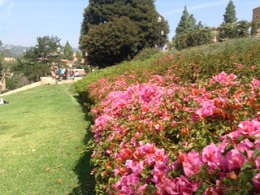
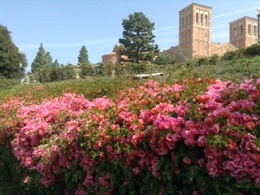
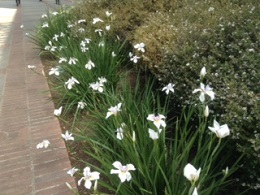
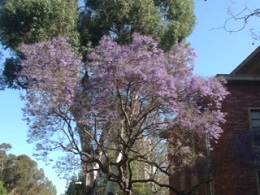
----------------------------------------------------------------------------------------
Date: Tuesday, March 31: 2015年3月31日(火)
Place: Around Royce Hall@UCLA: ロイスホール周辺










----------------------------------------------------------------------------------------



